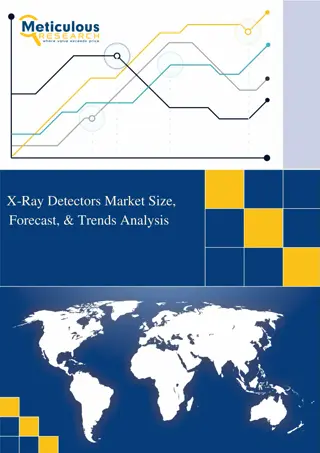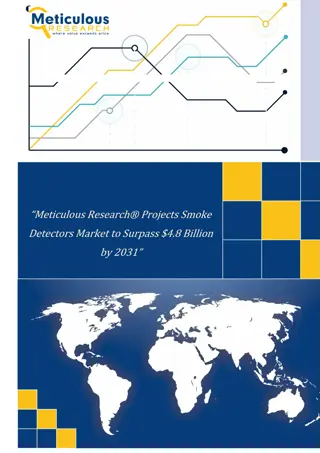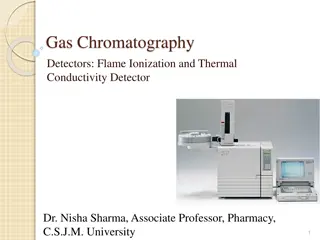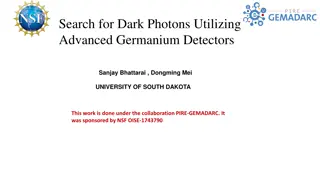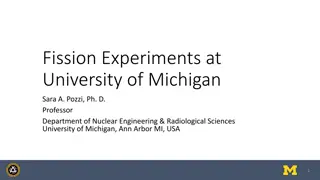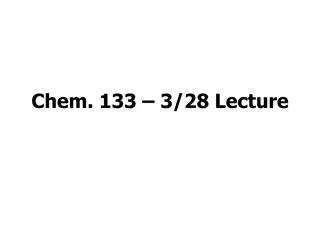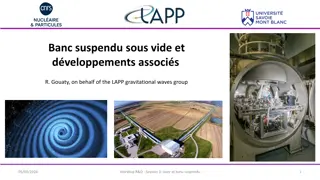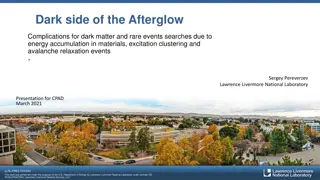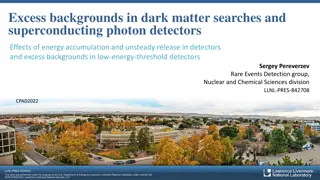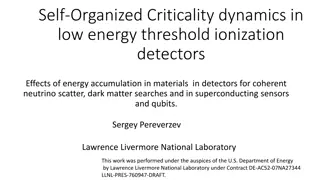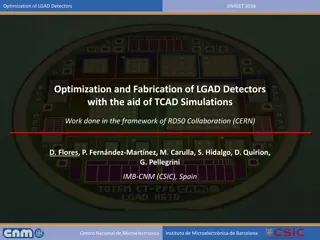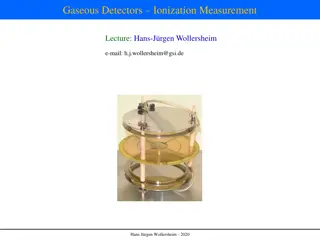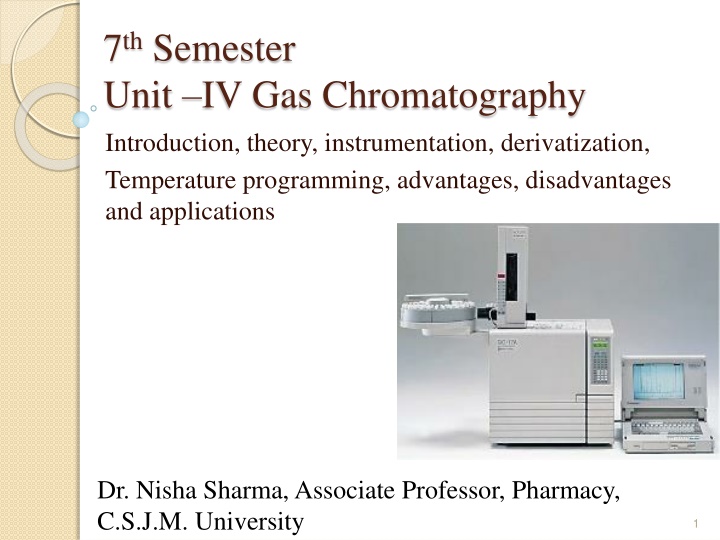
Gas Chromatography: Introduction, Theory, Instrumentation, and Applications
Explore the principles and components of Gas Chromatography, including detectors like Flame Ionization Detector and Thermal Conductivity Detector. Understand derivatization, temperature programming, advantages, disadvantages, and various applications in the field. Learn from Dr. Nisha Sharma, Associate Professor at C.S.J.M. University.
Download Presentation

Please find below an Image/Link to download the presentation.
The content on the website is provided AS IS for your information and personal use only. It may not be sold, licensed, or shared on other websites without obtaining consent from the author. If you encounter any issues during the download, it is possible that the publisher has removed the file from their server.
You are allowed to download the files provided on this website for personal or commercial use, subject to the condition that they are used lawfully. All files are the property of their respective owners.
The content on the website is provided AS IS for your information and personal use only. It may not be sold, licensed, or shared on other websites without obtaining consent from the author.
E N D
Presentation Transcript
7thSemester Unit IV Gas Chromatography Introduction, theory, instrumentation, derivatization, Temperature programming, advantages, disadvantages and applications Dr. Nisha Sharma, Associate Professor, Pharmacy, C.S.J.M. University 1
DETECTORS Flame Ionization Detector (Nanogram - ng) Temp. of H2 flame (H2+O2+N2) ionizes compds eluted from column into flame. Ions collected on collector electrode and recorded on recorder due to electric current. I=V/R Potential of 400 V across 2 electrode- lowers the resistance b/w electrodes & causes current to flow. Flame jet & collector position is 0.5- 1 cm above the tip of flame. Forms twin electrode 2
Current arises from the ions & free e-, generate in pure H2/air. When ionisable material from column effluent enters flame & burned, current rises abruptly. Current flows thru external resistor, sensed by voltage drop-amplified-sends output device recorder/ microprocessor. FID enclosed in chimney-heated sufficiently-to avoid conditions of H2O droplets-from combustion process. FID-responds- no. of CH2- grps. Introduced into flame. Eg. Response of equimolar amt. of butane is twice to ethane. No responses from fully oxidized C- carbonyl,-COOH gp. Ether grp. Response from C attached to OH, -NH grp. is If desired CO, CO2--- converted to CH4 by redn. with H over Ni cat.--- Measured 4
Flame Ionization Detector Column effluent is passed through a H2-Air flame Produces ions and electrons Charged particles are accelerated by voltage applied between jet and collector results in current Number of ions depends on number of reduced (methylene) carbons in molecule one molecule of ethane gives twice the signal of one molecule of methane less sensitive for non-hydrocarbon groups insensitive to H2O, CO2, SO2 and other noncombustibles Exhaust Chimney High sensitivity, low noise, destructive Collector Electrode Igniter Polarizing Electrode Column Effluent Hydrogen Inlet 5
Thermal Conductivity Basics katharometer Leads to W.S. bridge Metal block Filament Reference Carrier gas Carrier gas out R sample s A heated filament is cooled by the flow of carrier gas . 6
Thermal Conductivity Detector Principle: Electrical power is converted to heat in a resistant filament and the temperature climbs until heat power loss from the filament equals the electrical power input. The filament may loose heat by radiation to a cooler surface and by conduction to the molecules coming into contact with it. The ability of a colliding molecule to carry off heat depends on its thermal conductivity. Hydrogen and helium have high thermal conductivity and therefore will be more efficient at cooling a heated filament than other gases will. 7
Thermal Conductivity Detector The detector contains two filaments: one exposed only to carrier gas, while the other is exposed to the carrier gas for sample analysis. When the gas for the sample analysis is only carrier gas , the two filaments can be balanced. Instead of a direct measurement of filament temperature, the filament resistance, which is a function of temperature, is measured. 8
Thermal Conductivity Detector Measures the changes of thermal conductivity due to the sample (mg). Sample can be recovered. Heated filament is placed on the emerging gas stream. Amount of heat lost from filament by conduction to the detector walls depends on the thermal conductivity of gas phase With in the cavity of metal block- coiled filament- Tunsten metal, Tungsten rhenium alloy, tungsten sheathed with gold. Filament is heated to constant temp. but less than dull red, regulated by DC current Loss from filament to metal block is constant, when only carrier gas flows Thermal conductivity of H & He is 6-10 times greater than organic compounds 9
Thermal Conductivity Detector Presence of small amount of organic material results in relatively large decrease in TC of column effluent. Filament retains max. heat & Temp. rises & electrical resistance increases Standard detector: 4 identical filaments, mounted in 1 brass block Filaments form arms of a wheatstone bridge Through one pair of filament column effluent is passed & 2nd pair is places in gas stream near sample injection port Any imbalance b/w pair of filaments are recorded 10
Thermal Conductivity Detector When analyte comes, Filament Temp. rises When compound elutes, T.C. of gas mixture of carrier gas & compound gas is decreased Filament in sample column becomes hotter than other control column Resistance increases and imbalance b/w control and sample filament resistance is measured Ability of colliding molecules to carry off heat depends upon its TC. H & He have high TC & more efficiently cools in heated filament conc. sensing detector 11
Thermal Conductivity Detector Responds to all compounds, simple construction, Good , Adequate sensitivity to many compounds Good linear range of signal Simple construction Signal quite stable provided carrier gas flow rate, block temperature, and filament power are controlled The TCD is a nondestructive, concentration sensing detector. 12
Thermal Conductivity Basics When the carrier gas is contaminated by sample , the cooling effect of the gas changes. The difference in cooling is used to generate the detector signal. Leads to W.S. bridge Metal block Filament Reference Carrier gas Carrier gas out R Flow Flow sample s A heated filament is cooled by the flow of carrier gas . 13
Electron Capture Detector ECD detects ions in exiting from the gas chromatographic column by the anode electrode. 3H or 63Ni which emits particles. Ionization : N2 (Nitrogen carrier gas) + (e) = N2+ + 2e These N2+establish a base line X (F, Cl and Br) containing sample + (e) X- Ion recombination : X- + N2+ = X + N2 The base line will decrease and this decrease constitutes the signal. Insecticides, pesticides, vinyl chloride, and fluorocarbons 14
Electron Capture Detector (ECD): Carrier gas (and analyte) passes over -emitter, resulting in ionization and e- production Produces current between electrodes In the presence of other compounds (especially halogens, etc.) electrons are captured, causing decrease in current Most commonly used for halogenated organics (insecticides, etc.) As an analyte flows through Ni-63 source, electron capture is possible by electron-withdrawing species: A + e- => A- Current decreases as a result of e- capture by analyte. This is one of the few instances in which a signal is produced by a decrease in detectable phenomenon. 15
Electron capture detector Column effluent is passed b/w 2 electrodes One electrode has radioisotope on its surface that emits energy electrons ( particles as it decays) These electrons are bombarded with carrier gas N2 Results in formation of +ve ions, radicals, thermal electrons Process is very rapid < 0.1 sec. When Voltage is applied e- capture cell collect the thermal e- produce ve ions of large masses Rate of combination b/w ve & +ve ions is greater than thermal e- & +ve ions se in detector current due to removal of thermal e- in presence of e- capturing compounds measured 16
Electron capture detector Radio active sources: tritium adsorbed in titanium or scandium & Nickel 63 as foil placed on interior of cathode chamber Ni-63: 400 C Linearity of ECD- cell design, composition of carrier gas, method of applying P.D. to collect thermal e- ECDs - high selectivity, sensitivity towards certain organic species with electronegative functional groups. However, the detector has a limited signal range & is potentially dangerous owing to its radioactivity. In addition, the signal-to-noise ratio is limited by radioactive decay & presence of O2 within the detector. 17
ECD cathode electode 18
Mass Spectrometry Detectors Most powerful of all detectors. scans the masses continuously throughout the separation. When sample exits column, it passes through transfer line into the inlet of detector. The sample is then ionized & fragmented by electron-impact ion source. During this process, the sample is bombarded by energetic electrons which ionize the molecule by causing them to lose an electron due to electrostatic repulsion. Further bombardment causes the ions to fragment. 19
Mass Spectrometry Detectors The ions are then passed into a mass analyzer where the ions are sorted according to their m/z value, or mass-to-charge ratio. Most ions are only singly charged. The Chromatogram will point out the retention times and the mass spectrometer will use the peaks to determine what kind of molecules exist in mixture. mass spectrum of water with the absorption peaks at the appropriate m/z ratios. 20
Mass Spectrometry Detectors One of the most common types of mass analyzer in GC/MS is the quadrupole ion-trap analyzer, which allows gaseous anions or cations to be held for long periods of time by electric and magnetic fields. A simple quadrupole ion-trap consists of a hollow ring electrode with two grounded end-cap electrodes as seen in figure. Ions are allowed into the cavity through a grid in the upper end cap. A variable radio-frequency is applied to the ring electrode and ions with an appropriate m/z value orbit around the cavity. As the radio-frequency is increased linearly, ions of a stable m/z value are ejected by mass-selective ejection in order of mass. Ions that are too heavy or too light are destabilized and their charge is neutralized upon collision with the ring electrode wall. 21
Mass Spectrometry Detectors Emitted ions then strike an electron multiplier which converts the detected ions into an electrical signal. This electrical signal is then picked up by the computer through various programs. As an end result, a chromatogram is produced representing the m/z ratio versus the abundance of the sample. GC/MS units are advantageous because they allow for the immediate determination of the mass of the analyte and can be used to identify the components of incomplete separations. They are rugged, easy to use and can analyze the sample almost as quickly as it is eluted. The disadvantages of mass spectrometry detectors are the tendency for samples to thermally degrade before detection and the end result of obliterating all the sample by fragmentation. 22
GC/MS system. Arrangement of the poles in Quadrupole and Ion Trap Mass spectrometers 23
Other Detectors: Atomic Emission detector Microwave induced plasma, grating monochromator, diode array detector Thermionic Detector Photo ionization detector GC Chemiluminiscence detectors 24



